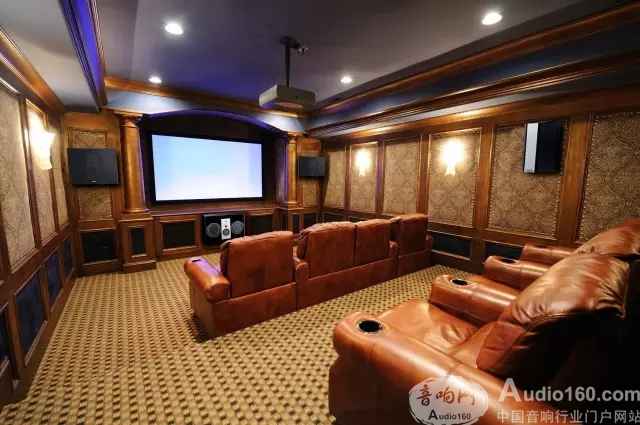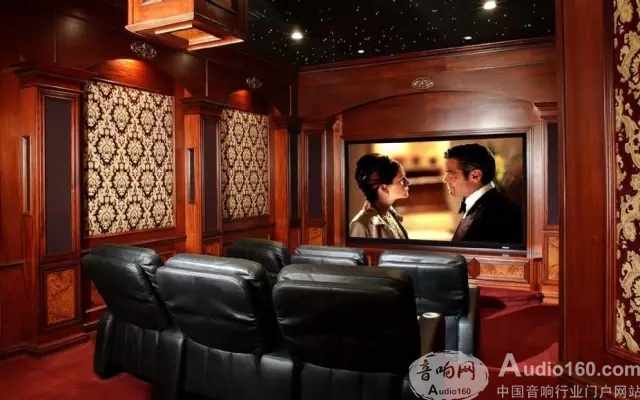Each room has different acoustic characteristics, and each sound space has different unique sound characteristics due to space size, proportion, and decoration design. Therefore, even the same audio equipment will produce different sound characteristics in different sound spaces. The successful sound space will create a charming sound charm, the following small series will introduce you to the 12 criteria of home theater audio acoustic processing: First, soft-tuning space is more suitable for listening to music Floors, ceilings, and walls with plywood, gypsum board or wooden boards are soft-tuned spaces. The space of reinforced concrete or brickwork is called hard-adjusted space. At present, most of the living environment in China is hard-adjusted. Because the hard-adjusted space can't properly absorb the extra high-pitched and mid-bass, it causes the treble of listening to music to be too harsh or the bass is too dull. Although the soft-tuning space may also have the disadvantage that the bass is excessively absorbed and the bass is not solid enough, it has been proved that the soft-tuning space is still suitable for listening to music. Second, the use of reflection, absorption and diffusion The purpose of carefully reflecting, reflecting and diffusing sound waves is to obtain a warm, full, soft, rich, clear, transparent sound. Third, the big space is better than the small space The volume of the large space is large, and the sound waves emitted by the speakers are less affected by the distortion of the boundary (six-sided wall), and the obtained sound is relatively correct. In a large space, if properly deployed, the obtained sound will be easier, uniform and correct. And the low frequency dive deeper. As for the standing wave, although the large space cannot be completely avoided, the degree of harm is relatively low. Fourth, equipment should be appropriate Each sound space will have its own sound characteristics. These sound features also need to be matched with appropriate speakers to play the effect of safflower green leaves. The better the sound space layout, the wider the range. Conversely, if the sound space is not ideally arranged, only a few devices can be found to accommodate such a biased space. The size of the space is different, and the speakers are different. It is futile to use a large speaker in a small space or a small speaker in a large space. It depends on a wealth of experience to achieve perfect results. 5. Rational enthusiasts should minimize exclusivity It is inevitable that each enthusiast will develop his own listening habits and preferences because he is in his own audio space for a long time. Based on these habits and preferences, it is easy to judge other people's audio space and listening habits and preferences. . Therefore, when you hear different sound performances, don't make any exclusive comments first, but try to find out the strengths of others' sound effects. Sixth, try to transform the hard-adjusted space into a soft-tuned space If you want to turn the hard-adjusted space into a soft-tuned space, you can first transform the four-sided wall. For example, use a gypsum board to nail the interlayer, and the interlayer is covered with fiberglass. This will not reduce the amount of interlayer space, but also improve the sound insulation. The reason for using gypsum board or splint is that thin splint or wooden core board is easy to absorb midrange, and gypsum board is heavier, absorbs more bass, and has less negative impact on listening music. In addition, the gypsum board is a fireproof material and is used for sandwiching. Seven, the second remainder diffuser is very easy to use Diffusion is the sound wave emitted by the speaker, which is reflected uniformly in all directions, no matter from which direction, the general sound reflection is usually oriented. Theoretically, as long as the length of the reflecting surface is greater than the wavelength of the acoustic wave, all sound waves whose wavelength is shorter than the reflecting surface will be reflected in a certain direction. What the acoustic space needs is diffusion, not directional reflection. Because the diffusion will make the sound waves in the room more uniform, and the directional reflection will only affect a certain part. Eight, the sound effect of the sound space should be based on live music The standard of sound space sound effects is not unique, but multiple. The standard of sound effects is based on the performance of live music. The sound effects of live music are not unique, but multiple. As far as classical music is concerned, there are many outstanding concert halls in the world, each with different sound characteristics. Some are warm, some are full, some are clear and transparent, some are rich in low frequency, some have a good sense of sound, and the sound characteristics of these concert halls have their own strengths. Affected by the unknown sound recording site sound characteristics, sound recording equipment sound characteristics, replay equipment sound characteristics and sound space sound characteristics, enthusiasts can only be based on the performance of live music, and is a multiple standard. Nine, standing wave should only be taken Standing wave is the resonance phenomenon of space. As long as the distance between two opposing parallel walls is equal to an integral multiple of half wavelength, resonance will occur and a standing wave will be generated. If the standing waves generated by the three parallel walls in space have overlapping frequencies, A stronger standing wave will be formed. The standing wave does not have a single frequency, and its frequency range is very wide. People cannot accurately "offset" it with some measure. At the same time, the energy of the standing wave is very strong, usually much higher than the sound pressure of normal music, so it can't be dealt with with the "fine tuning" voice tuning technique. The best way to deal with the standing wave is to avoid it by using the speaker position and changing the listening position. Ten, the space should be surface treated After changing the acoustic space from hard to soft, the surface should be treated in the same way as "pre-hard, medium-suction, and post-diffusion". The so-called "pre-hard" refers to the front section of the room (between the back wall of the speaker and the speaker). Do not add absorbing materials as much as possible. Otherwise, the output power of the amplifier must be increased to make the sound solid. If the power output of the power amplifier is not very large, the speaker is not very large. It is recommended not to nail the plasterboard on the back wall. The so-called "middle suction" is to absorb the surface of the sound between the speaker and the listening position. The purpose is to weaken the first reflection, improve the positioning and clarity, and avoid the sound is too bright and too harsh. "Sucking" There are many ways to do this. The cheapest and most effective material is fiberglass. For example, a glass wool having a thickness of 5 cm and a weight of 20 kg per cubic meter has an absorption rate of up to 85% for frequencies above 500 Hz. The fiberglass cotton can be wrapped (not exposed) to form the shape of the image frame, which is the first reflection sound absorber of the two sides of the wall. The so-called "post-diffusion" is to spread the area from the listening position to the back wall. The correct way is to put two diffusing plates in the two corners of the back wall, and then put a diffusing plate in the center of the back wall to play the real Diffusion effect. After the sound wave is evenly diffused, the sound wave reflections heard everywhere in the listening area are average, and the listening position is not limited to the "emperor position"; and it can significantly improve the sound quality, tone color, layering, depth, etc. . XI, space decoration skills The indoor items absorb and reflect the sound waves and naturally adjust the reverberation. The heavier the weight, the more the medium or low frequency absorption, the lower the standing wave can sometimes be mitigated. The multi-fiber, porous soft surface has a strong absorption of high frequency, such as the surface of the flannel sofa, the carpet flannel and so on. It is worth noting that it is best not to use glass doors for all kinds of furniture in the sound space. 12. The quadratic residue diffuser has a special diffusion characteristic. If the center frequency is used as a reference, its diffusion low limit can be extended down to about half the frequency below the center frequency (if the center frequency is 1000 Hz, the half frequency is 750 Hz), and the upper limit can be as high as the center frequency N- 1 time. Assuming a center frequency of 1000 Hz, the step of the quadratic residue diffuser is 7, and the upper limit of the diffusion range is about 6000 Hz. Screw Terminal Connector,Pcb Screw Terminal,Screw Terminal Block Connector,Screw Type Terminal Blocks Cixi Xinke Electronic Technology Co., Ltd. , https://www.cxxinke.com
